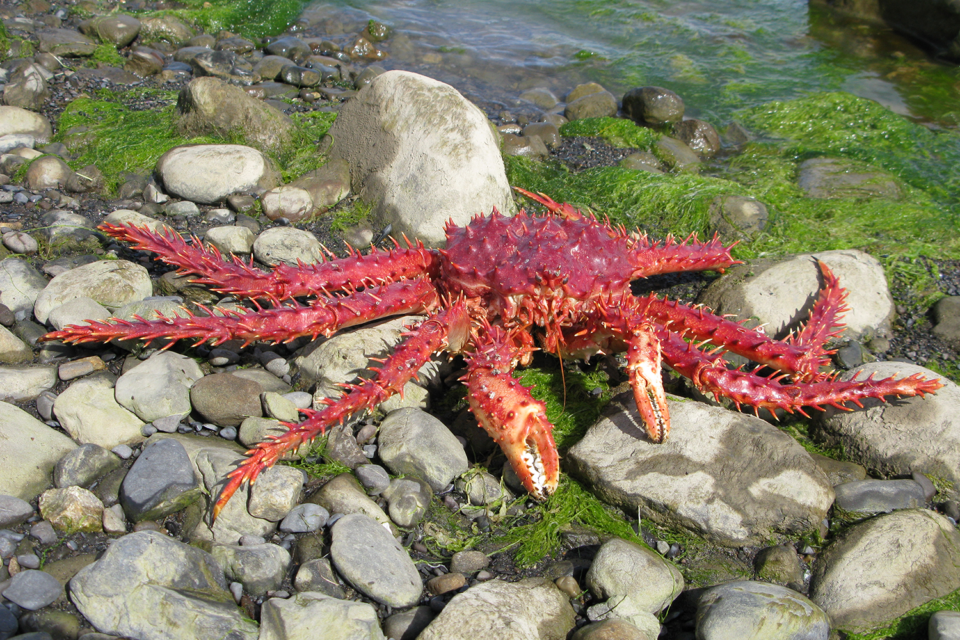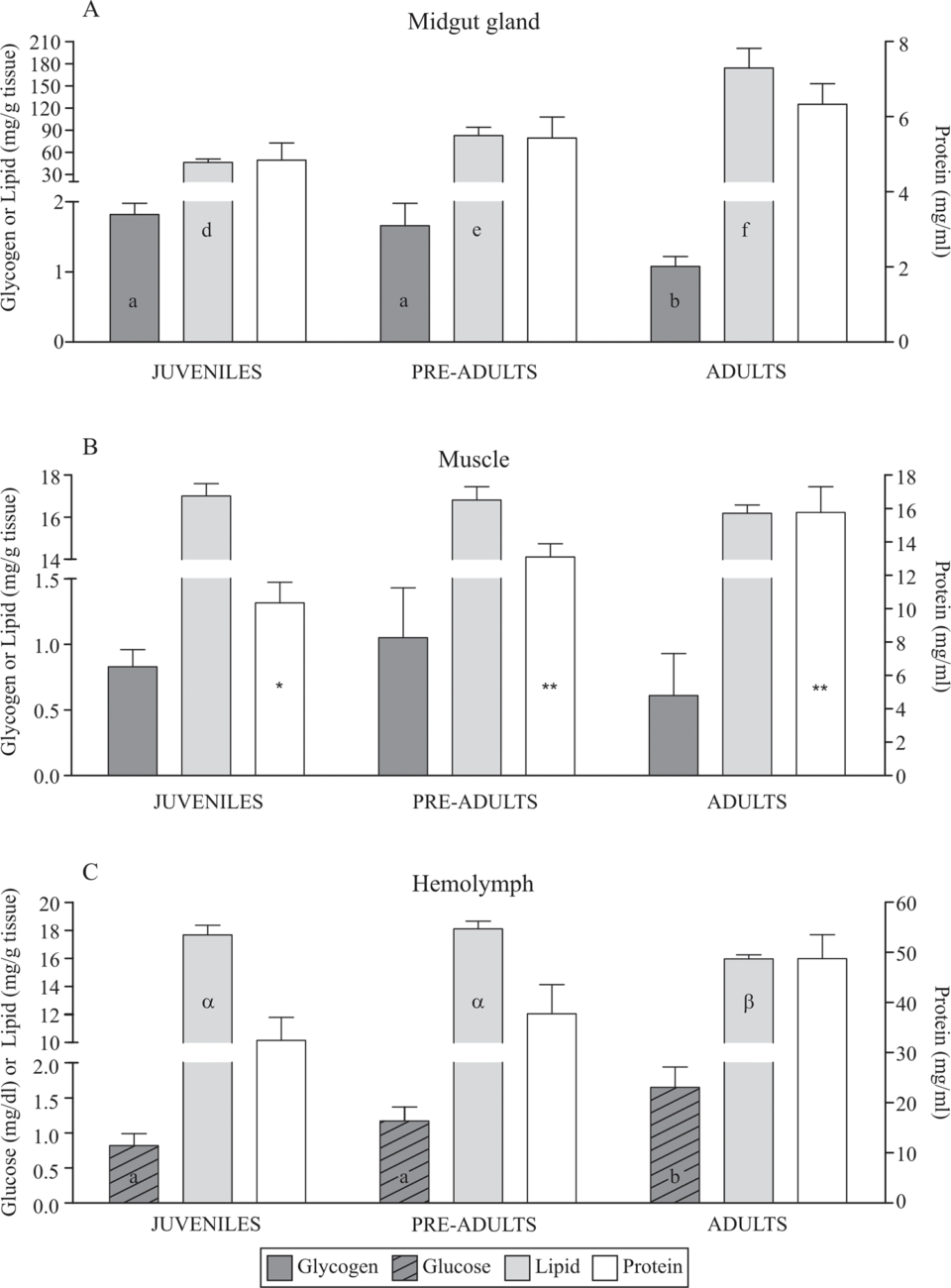Results improve knowledge of dietary requirements for aquafeed formulation

Although important for their maintenance in culture conditions, there is limited knowledge about the nutritional and energy requirements in these species of crabs. A sub-optimal diet can affect animal growth under laboratory conditions and promote cannibalism. Studies on physiologic and energetic changes throughout their development can be useful for understanding the nutritional requirements for adequate diet formulation and optimization of husbandry practices for L. santolla, and for a better understanding of the ecological role the species has in its ecosystem.
From an aquaculture perspective, an adequate understanding of the energetics of the different crustacean developmental stages is essential, because animal growth may be related to the survival of individuals during their early stages. Since direct measurements of the energetic content and metabolic heat production are not always possible, the parameters of bioenergetic budgets are usually estimated with indirect methods.
This article – adapted and summarized from the original publication – evaluated the biochemical and physiological changes through the quantification the energetic reserves, digestive enzymes, amino acid profile and energy in the midgut gland, muscle and hemolymph of juveniles, pre-adults and adults of wild L. santolla, to provide relevant information to improve indoor culture practice.
Study setup
Twelve juvenile L. santolla (six males and six females; average weight 14.40±2.67 grams; carapace length, CL, 27.75±2.16 mm) and 10 pre-adult crabs (six males and four females; average weight 160.35±13.32 grams; CL 62.10±1.61 mm) of in intermolt stage were collected by scuba diving at depths of 6 to 12 meters from the subtidal zone of the Golondrina Bay in the Beagle Channel (Ushuaia, Argentina). Ten adult crabs (five males and five females; average weight 940±125 grams; CL; 106.78±4.51 mm) were captured in Punta Oriental (Beagle Channel) using baited commercial traps.
The crabs were transported to the aquarium facilities of the Centro Austral de Investigaciones Científicas (CADIC), Ushuaia, and maintained in individual plastic containers in a chilled seawater recirculation system at 6 to 8 degrees-C, a photoperiod cycle of 10 hours light:14 hours dark (resembling the Beagle Channel day/night cycle at the time of their collection from the wild), and were not fed. and without food. The animals were kept under these conditions for 48 hours, and then sacrificed and dissected, and various body samples collected for analyses.
For detailed information on the experimental setup, sample collection and sample and statistical analyses, refer to the original publication.
Results and discussion
Results of our study provide new and relevant biological information on physiological changes during the development of L. santolla, which can help support its culture. The main results of our research reveal that the juveniles, pre-adults and adults present dissimilar physiological profiles according to multiple parameters like glycogen and lipids reserves; lactate, proteinase and lipase enzymes; amino acids profile and energy content.
We determined that lipids are the most important energetic reserve in adult crabs, probably associated with reproduction. Contrarily, glycogen is the most important energetic reserve during the first years of crabs, perhaps associated with high both metabolism and molting rate. Specifically, the lipids reserves increase ontogenetically, whereas the glycogen reserves of the midgut gland decrease in adult crabs. Molt frequency progressively decreases with crab size, with adults molting annually, and juveniles molting at least 20 times during the first three years of their life span.

In crustaceans, the molting process requires high levels of energy and the high molting frequency of juvenile crabs coincides with their high metabolism demand and thus the storage of glycogen as a molecule of rapid availability of energy. But the higher lipid concentration in adults is related to the reproductive and growing processes. These energetic demand processes should be based on molecules that can be stored for long periods, like lipids, either in the midgut gland or in the ovary, depending on their destination (molting or reproduction).
During their development, the capability of the crabs to digest lipids was higher than for proteins and changed with animal size. Juvenile and pre-adult crabs had higher protein digestive capacity, while adult crabs had higher lipid digestive capacity). Our results suggest that juveniles and pre-adult crabs feed on protein-rich foods, while adult crabs feed on lipid-rich foods. Studies on wild crab populations have shown this change in food habits as the animals grow and develop.

Dietary protein requirements are particularly high in rapidly growing, early life history stages with a high metabolism, to support tissue synthesis. In studies on amino acid requirements, the reference of the dietary amino acid profile is mostly based on either crustacean whole body or tail muscle composition. Our data provides the essential amino acid requirements for L. santolla, and supports the formulation of culture diets and the feasibility of incorporating vegetable protein sources. Our results suggest that high levels of methionine, arginine, tryptophan and cysteine amino acids will be needed for an adequate diet formulation for this crab species.
The muscle of L. santolla juveniles has high amounts of methionine, arginine, tryptophan (9 percent, 11.4 percent and 12.6 percent respectively) than the muscle of pre-adults and adults. Methionine and arginine are essential amino acids that are critical for optimal growth and survival of crustaceans.
Also, L. santolla has high concentrations of non-essential amino acids (NEAA): aspartic acid, glutamic acid and glycine (6.8 percent, 8 percent and 14 percent respectively), and similar results have been reported for other decapod crustaceans. Our research is the first report of an amino acid profile of the muscle of L. santolla, and this information provides the essential amino acid requirements of this species to formulate a diet for its culture.
Cannibalism is one of the main reasons for failures in the development of culturing methods for a variety of crab species. It can be triggered to compensate for nutritional deficiencies and/or low feed palatability. During the early stages of crustacean juveniles, cannibalism can be particularly intense, because of their high metabolic and growth rate, which, in turn, causes losses in cultures through mortality. Knowledge on the amino acid profile of juvenile crabs could have a direct application by reducing cannibalism in cultures. For example, the essential amino acid tryptophan is the precursor of serotonin, a neurotransmitter that is linked to aggressive behavior.
Also, dietary supplementation with high tryptophan levels causes an increase of serotonin concentration, and thus suppressing aggression and improving the survival of some cultured fish and decapod crustaceans. In our study, we observed that the muscle of juvenile crabs has high amounts of tryptophan. However, under laboratory conditions, cannibalism is frequent when early stages are pooled together, and this behavior occurs during both intermolt and molting periods.
Perspectives
The biochemical and nutritional information generated in this study improves the understanding of the body nutrient levels of L. santolla and the amino acid profile of its body tissues, as well as its dietary requirements. This information is relevant for the formulation of balanced diets for this valuable crab species.
The physiological changes we observed during our study indicate that juvenile L. santolla have high protein dietary requirements, with methionine, arginine, tryptophan and cysteine as crucial amino acids during their early development. Juvenile and pre-adult crabs have similar dietary requirements and an amino acid profile comparable to that of adult crabs. From previous studies and our results on lipid digestive capacity and lipid reserve of the midgut gland, we propose that adult crabs obtain their energy mainly from dietary lipids.
Our results improve the understanding of the physiology, energetic and nutritional requirements of L. santolla, and are the starting point for current research on diet formulation for the culture of this valuable crab species.
References available from the original publication.
Now that you've finished reading the article ...
… we hope you’ll consider supporting our mission to document the evolution of the global aquaculture industry and share our vast network of contributors’ expansive knowledge every week.
By becoming a Global Seafood Alliance member, you’re ensuring that all of the pre-competitive work we do through member benefits, resources and events can continue. Individual membership costs just $50 a year. GSA individual and corporate members receive complimentary access to a series of GOAL virtual events beginning in April. Join now.
Not a GSA member? Join us.
Authors
-
Dr. Hernán Javier Sacristán
Corresponding author
Centro Austral de Investigaciones Científicas (CADIC), CONICET, Ushuaia, Argentina[114,97,46,98,111,103,46,116,101,99,105,110,111,99,45,99,105,100,97,99,64,110,97,116,115,105,114,99,97,115,110,97,110,114,101,104]
-
Dr. Jesica Romina Mufari
Instituto de Investigaciones Biológicas y Tecnológicas (IIByT), CONICET, Córdoba, Argentina
-
Centro Austral de Investigaciones Científicas (CADIC), CONICET, Ushuaia, Argentina
[111,122,110,101,114,111,76,32,111,105,110,111,116,110,65,32,111,103,105,114,100,111,82,32,46,114,68]
-
Dr. Claudia Clementina Boy
Centro Austral de Investigaciones Científicas (CADIC), CONICET, Ushuaia, Argentina
-
Dr. Gustavo Alejandro Lovrich
Centro Austral de Investigaciones Científicas (CADIC), CONICET, Ushuaia, Argentina
Tagged With
Related Posts

Responsibility
Improving shrimp farm design in flood-prone areas of India
Shrimp farm design improvements like reservoirs and recirculation canals can help small-scale shrimp farmers protect their infrastructure and improve production in flood-prone areas of India and elsewhere.

Innovation & Investment
Artemia, the ‘magic powder’ fueling a multi-billion-dollar industry
Artemia, microscopic brine shrimp used as feed in hatcheries, are the unsung heroes of aquaculture. Experts say artemia is still inspiring innovation more than 50 years after initial commercialization. These creatures are much more than Sea-Monkeys.

Health & Welfare
In situ detection of blue crab reovirus
An in situ hybridization procedure can be used to diagnose blue crabs from Chesapeake Bay infected with a reovirus.

Health & Welfare
Can farming horseshoe crabs help the COVID-19 cause?
Already housing horseshoe crabs for medical purposes, researchers hope recirculating aquaculture systems will aid their coronavirus-fighting efforts.


